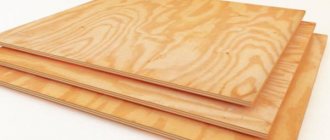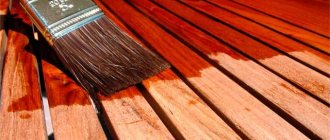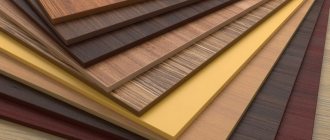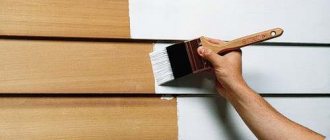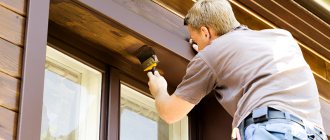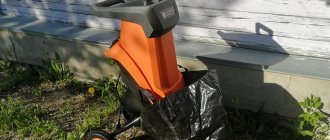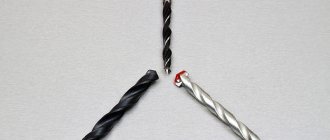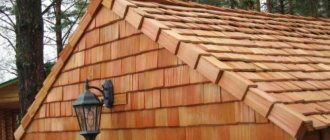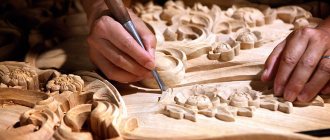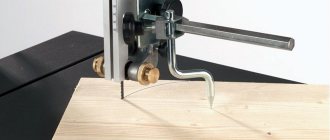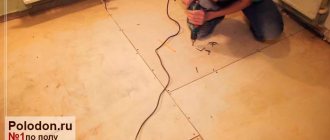SHARE ON SOCIAL NETWORKS
FacebookTwitterOkGoogle+PinterestVk
Furniture, floor and wall coverings, as well as many other finishing materials are made from MDF boards. However, not everyone understands what this abbreviation means. In the article we will look at all the available information about MDF panels: what it is, what it is used for, what advantages this material has, thanks to which it is so actively used today.
MDF is a medium density fiberboard
How to distinguish MDF from chipboard?
First, let's figure out how these names are deciphered. MDF is a fine wood fraction, and chipboard is a laminated chipboard. Both are made from wood waste, but the properties of these materials are different. Chipboard is made from larger chips. Therefore, to distinguish it from MDF, it is enough to look at the cut and pay attention to the structure. If you clearly see sawdust there, you have chipboard in front of you.
Content
- What is it and scope of application
- Features and Benefits
- Features and sizes of MDF
- Forms and methods of material processing
- Varieties
- Laminated
- Veneered
- For painting
- Decorative wall panels
- Moisture-resistant panels
- Glossy canvases
- Flexible panels
- Kronospan
MDF is a medium density fiberboard. The abbreviation stands for Medium Density Fiberboard. This is a material that is quite in demand on the construction market and is used for the production of interior and decorative items. If your choice fell on MDF: what kind of material it is and where it is used, it will be useful to find out before you start using it.
Chipboard production? How to define quality?
To produce chipboard, sawdust and shavings are compressed and impregnated with formaldehyde resins for gluing, and the resulting board is usually laminated with melamine film.
The letter “L” at the beginning of the abbreviation indicates that the chipboard is laminated. The film not only protects the slab from moisture and other external influences, but also prevents the release of formaldehyde into the external environment. There is a safety classification for laminated chipboards based on the concentration of formaldehyde:
- E1 – formaldehyde emission class, considered safe for furniture production (this board is made according to European standards;)
- Class E2 - strictly prohibited for use in the production of children's furniture;
- Class E 0.5 – also complies with European quality standards. However, its use is not always necessary, since the film prevents the evaporation of the harmful compound;
- E 3 – strictly prohibited for use in production.
When buying furniture, be sure to ask the seller about the safety class and ask for certificates.
Comparison of characteristics
To choose the most suitable option for rough or fine finishing of a floor structure, it is necessary to take into account the main parameters of the product.
Environmental friendliness
Health safety is one of the main factors. The indicators of wood-based panel materials comply with the standards reflected in standardization documents.
- Plywood. Eco-friendly option. The most harmless products are those that are glued using natural resins.
- OSB. It does not pose a threat, but only if the production technology is followed. It is better to choose trusted manufacturers.
- Chipboard. This variety causes the most controversy regarding health hazards, since formaldehyde resins are used for gluing. Products must comply with standards (marking E1 or E0.5).
- Fiberboard. Does not pose a threat provided that high-quality raw materials are used.
- MDF. Eco-friendly material made using urea resins. These products must also comply with class E1 or E0.5.
Since the outside of all materials is finished, harmful fumes are minimized.
Strength
To choose the most reliable option, you need to take into account the density and structure of the product:
- OSB and plywood. Oriented strand panels can withstand heavy loads well: the layers are placed in different directions and glued together extremely firmly. But wood-laminated board may have a significant disadvantage - the possibility of deformation due to non-compliance with the technology.
- Chipboard and fibreboard. They have sufficient hardness. Their areas of use are somewhat different. Wood-shaving parts are thick, and wood-fiber parts are very unstable in bending, so they cannot be used for leveling voids.
- MDF. A relatively soft material that is not used in places with high loads.
It is difficult to compare all products on this parameter, since they have different sizes.
Dimensions
The length and width of all varieties are approximately the same, so it is necessary to compare the thickness:
- Hardboard. The thinnest material. Its thickness can reach up to 7 mm, but the most common is 3.2 mm.
- Plywood. For the floor, products with a thickness of 12–15 mm are selected.
- OSB. Can be of different sizes, but for flooring options from 10 to 22 mm are used. If you need to level the existing base, then a thickness of 1 cm is suitable, but in order to lay the material on wooden logs, the parts must be more durable.
- MDF. Due to their softness, the recommended thickness of the slabs varies from 18 to 25 mm.
- Chipboard. For horizontal structures with increased load, a tongue-and-groove version with a thickness of 16–22 mm is used.
The thickness and structure of the parts also affects protection from sound penetration and heat retention. If the noise pollution is very strong, then it is recommended to give preference to medium-density fiberboards of maximum thickness. They also serve as additional thermal insulation, which is similar to OSB.
Price
The difference in the price of materials depends on many factors: production method, raw materials used, additional processing, size and even place of sale.
- The most expensive is high-grade plywood.
- The cost of MDF is calculated per square meter and depends on the manufacturing method.
- The price of OSB-3 and 2 corresponds to wood-laminated boards of grade 3 or 2 of a smaller size.
- The lightest and cheapest option is fiberboard.
To ensure that the total work budget does not amount to too significant an amount, it is necessary to immediately determine the scope of application of each type of product.
Easy to install
Laying wood boards is not difficult; it does not require professional skills or complex tools. The order of work depends on the specific situation:
- If a frame structure is being erected, then OSB would be the best option.
- The light weight and thickness of hardboard make processing the fastest, but it is not suitable for serious leveling.
- Chipboard and OSB panels are cut and fixed almost identically. They are much easier to trim than MDF, which due to its dense structure offers more resistance.
- The most labor-intensive material to process is plywood. It will take much longer to place the product. It is more difficult to drill or adjust to size due to the presence of layers of natural wood in the structure.
All floor slabs are mounted on glue or joists, the only exception is the fiberboard covering: these sheets are not intended for laying on joists, they need a flat and durable base
How is MDF made? How to define quality?
To produce MDF, wood is crushed, dried and pressed.
Lignite, a natural substance found in wood, binds wood particles together instead of resins. There are practically no formaldehydes in MDF, and in terms of chemical safety the material is as close as possible to natural wood. For protection, PVC film, veneer or enamel is applied to it. The photo below shows the EGGER chipboard we use in production:
The production technology consists of 4 stages:
- The first stage is the preparation of raw materials. To produce MDF, round logs are used, the bark is removed from them using special equipment, chopped into small chips, sorted, washed, removing dirt, sand and pebbles, and heated with steam.
- In the second stage, the fibers are prepared. In the refiner, the material is crushed, the resulting mass is dried and receives a mass of equal moisture content, after which the air is drawn out of it.
- The third stage is pre-compression. The fibers are processed on a special forming machine, where the plate is formed. It is leveled, pre-weighed and pre-pressed, thereby losing air.
- The final stage. Last pressing. The slab goes through the main press, from which the finished MDF strip comes out. It is further cut and cooled for half an hour.
What is stronger - MDF or chipboard?
MDF is denser not only than chipboard, but also solid wood.
This material is not afraid of high humidity, so it is suitable for use in the bathroom or kitchen. MDF is a more flexible material, so furniture of complex, streamlined shapes is made from it. It is also good for deep milling and drawings due to its fine structure and high density. Chipboard is less durable than solid wood and MDF. It is not recommended to use it in bathrooms and kitchens, since moisture can seep inside through cuts and peelings on the film. This causes swelling, change in shape and further reduces strength.
Advantages
- The versatility of the material. Due to the structure of the material, it is very popular and widely used in various areas of human life: furniture industry, construction, interior design.
- Practicality. MDF is a fairly hard material and is not subject to minor mechanical damage. In addition, due to their density, the slabs perfectly hold fasteners, which significantly extends the life of furniture, wall or ceiling panels.
- Decorative. A rich variation range of MDF boards allows even the most demanding consumer to choose an option.
- Environmental friendliness. In the manufacture of MDF panels, no synthetic additives are used, which makes it possible to compare the safety of the material with natural wood. The use of natural ingredients makes MDF safe for health. Even over time, the material does not emit toxic compounds.
- Hygiene. Fiberboards are not subject to the natural process of decay, as well as to the influence of other pathogens that destroy the base of the material.
- Moisture resistance. MDF is not exposed to moisture, does not swell or warp.
- Uniformity of the material. MDF boards are made from a homogeneous mass of wood fibers mixed with an adhesive composition, which guarantees the absence of external and internal defects. The slabs are absolutely smooth and even.
- Lifetime. Compared to solid wood furniture, MDF products will last much longer if properly cared for.
- Heat and sound insulation.
What is cheaper than MDF or chipboard and why?
MDF is one and a half to two times more expensive than chipboard, and is used for the premium and luxury segments. Economy segment products are always made from laminated chipboard. The final cost of the product may be influenced by the finishing material. The most budget-friendly ones are PVC film and sheet plastic; enamel is somewhat more expensive. The most expensive finish is natural veneer.
Types of slabs
Depending on the finishing of the surface of the slabs, they are divided into three pits:
Laminated
Such slabs are covered on the front side with a special PVC film. The lamination process consists of gluing the film to a wood board, which occurs under pressure.
The result can be either a glossy or matte surface. The surface of such canvases can imitate wood. And if colored lamination is used, this makes it possible to choose absolutely any shade, which is especially important when making furniture facades. Their main qualities include:
- strength;
- UV and moisture resistance;
- hygiene;
- resistance to chemical detergents;
- Dirt resistance.
Information on how to use wide MDF floor skirting boards most effectively during repairs can be found in the article.
Veneered
Veneer made from valuable tree species is glued to one or both sides of MDF boards. This is not a cheap type, so it is rarely used. After veneering the canvas:
- are made moisture resistant;
- become resistant to warping;
- do not dry out.
For painting
These are solid pressed boards; their surface can be painted to protect the material from external negative influences. Canvases are painted manually or using a machine method. Dyed canvases are characterized by low cost and the same quality of material. You can find out about chipboard or MDF: which is better to use for repairs from the article.
So how to choose the material for your furniture?
Here is our memo in the form of simple theses:
- Laminated chipboard is perfect for the living room and hallway. Just make sure that the stove is of high quality. Request a certificate confirming the class of the slab.
- The combination of chipboard and MDF is suitable for children's bedrooms and bedrooms, but the rule is the same: the material must be of high quality, and the product must be well glued, including edges and joints.
- For the kitchen and bathroom, it is better to choose MDF: in these rooms it is most often exposed to changes in temperature and humidity.
General requirements for care and operation
When choosing a place for furniture made of MDF or laminated chipboard in the kitchen, you must take into account that both materials are resistant to temperatures above 75 ℃. When exposed to high heat, the coating begins to peel off. For this reason, heating devices should not be placed in close proximity to furniture.
If a furniture set is constantly illuminated by the bright sun, then it may simply fade and lose its attractiveness. Chipboard lamination is especially susceptible to fading.
Severe wetting of the slabs is undesirable, although they can withstand short-term exposure to water well, which is why they are used for sinks and other kitchen furniture. Much depends on the quality of the material. There are often cases when laminated chipboard sheets begin to become saturated with water, swell, and crumble. Such furniture takes on a terrible appearance, is destroyed, and becomes completely unusable.
General rules of care are:
- wipe the dust with a dry cloth or a special compound for plastic;
- promptly remove moisture from the surface with an absorbent sponge;
- do not overload hooks and shelves so that fasteners do not break off;
- Do not use waxes and mastics intended for polished wood.
The last point is worth focusing on. Polishing agents intended for wood are not suitable for MDF and laminated chipboard. The laminated film may change color under their influence and even peel off. You should also not use acids, alkalis, or abrasives.
Both types of slabs are resistant to pests and mold. In a dry room, they can stand for decades without any additional treatment without collapsing. They are used to make beds, tables, cabinets, chests of drawers, bookcases, shelves, and all kinds of kitchen cabinets.

